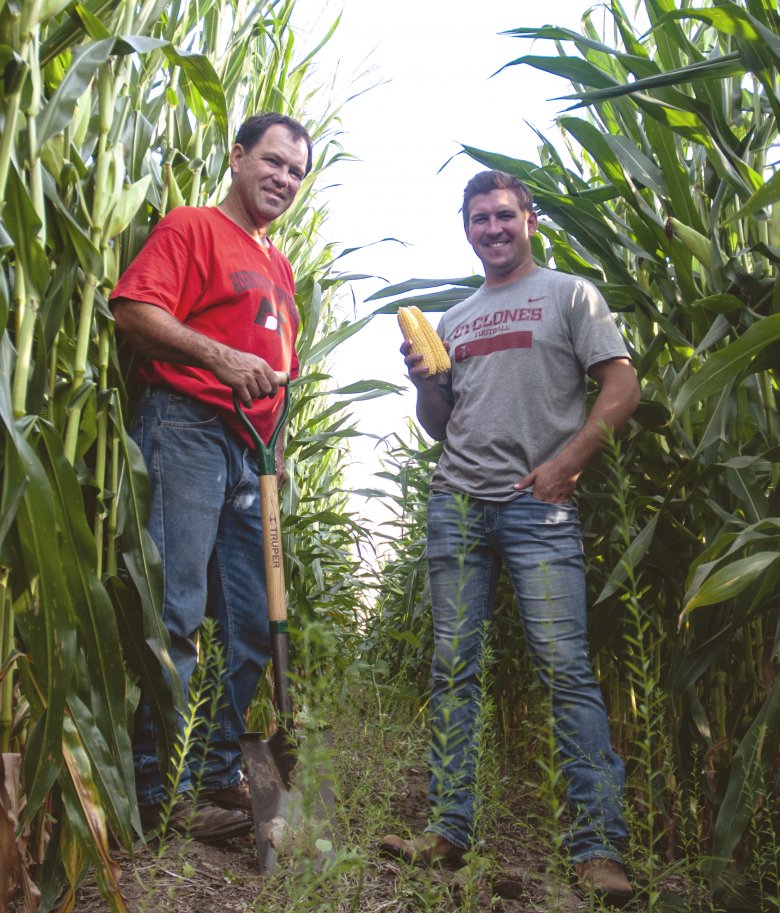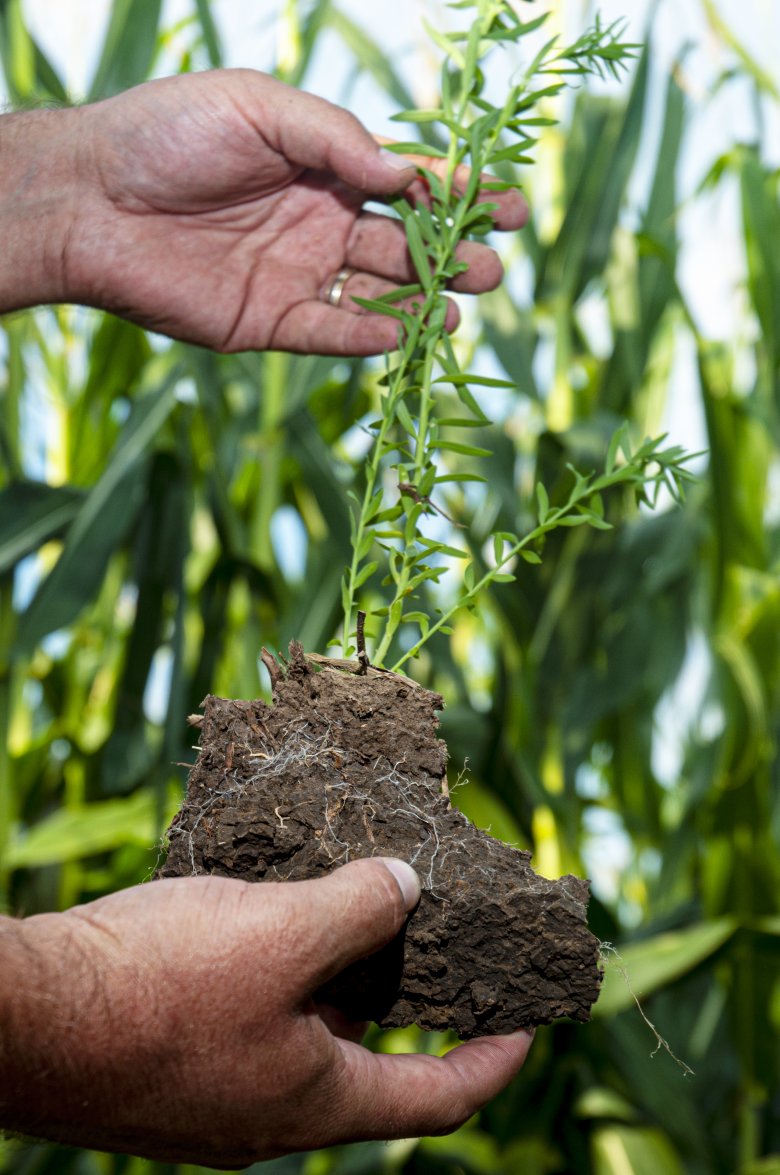Bigger is nearly always better, except when it comes to corn row spacings. They’ve shrunk, narrowing over the decades from 38 inches to today’s standard of 30 inches down to less frequent 15-inch spacings.
Jim Purfeerst, though, is heading the other way on a 20-acre field near Faribault, Minnesota. He’s testing corn planted in:
- 30-inch spacings with no cover crops
- 30-inch spacings with cover crops
- 60-inch spacings with cover crops
- 90-inch spacings with cover crops
His field is part of a three-year trial with four farms that are testing the planting of cover crops into wide rows. The trial, funded by the Minnesota Department of Agriculture’s Sustainable Agriculture Grant, is being conducted by the Cannon River Watershed Partnership (CRWP) and the University of Minnesota (U of M).
“We want to see the effect of these wide rows on cover crop growth, quality, and value,” CRWP conservation program manager Alan Kraus says of the trial’s four farms.
The wide rows enable more sunlight to penetrate cover crops compared with 30-inch rows. This can spur more photosynthesis that triggers increased growth and improved forage quality, says Kraus.
This not only stimulates soil health benefits like increased water infiltration, but also prompts potential financial returns from livestock grazing or the mechanical harvesting of high-quality forage, Purfeerst adds.
Following harvest, Purfeerst’s cows have binged on a buffet of annual ryegrass, bahu kale, purple top turnips, African cabbage, and berseem clover. In 2020, Purfeerst baled the mix to feed it to cows at farm headquarters.
“They love it like candy,” says Purfeerst, who also works with his sons Mark and Matt on the farm.
So What’s Not to Love?
Drawbacks include lower yield potential, as corn typically yields less in 60-inch and 90-inch rows than in 30-inch rows.
Although data are still being compiled on a statistically significant basis, corn in 60- and 90-inch rows has roughly yielded 15% to 20% less than corn growing in 30-inch rows in 2019-2020 CRWP trials, says Kraus.
Lower yields don’t always occur, though. In 2020, Purfeerst’s corn planted in 60-inch rows with cover crops yielded 224 bushels per acre. This eclipsed the 209.4- and 217.7-bushel-per-acre yields for corn planted in 30-inch rows with no cover crops and cover crops, respectively.
Overall, corn hybrids planted in 60-inch rows in North Dakota State University (NDSU) trials have yielded 95% of what they yield in 30-inch rows, says Kelly Cooper, an NDSU research agronomist. Still, a handful of hybrids have yielded more in 60-inch spacings compared with 30-inch spacings.
“We’d like to further look at those hybrids,” he says. “The problem is that hybrids change so quickly these days. I don’t think we can hang our hat on just one hybrid.” One potential avenue Cooper may explore is photosynthesis efficiency differences among hybrids.
Hybrids matter, agrees Mitchell Hora, who farms with his father, Brian, near Ainsworth, Iowa. Their 2019-2020 on-farm trials resulted in similar yields between corn planted in 30-inch spacings and those seeded in 60-inch rows that were interseeded with a multi-species cover crop.
Planting 60-inch rows north and south could also account for yield similarities, he adds, as it may increase photosynthesis fueled by the sun’s daily movement.
“East-facing rows receive full sun in the morning,” Mitchell Hora says. “Cover crops [between corn rows] then receive full sun in midday, followed by west-facing corn rows in late afternoon and early evening.”

Photo credit: Gil Gullickson
Brian and Mitchell Hora say 60-inch spacings benefit both corn and cover crops.
Think Biomass
An even bigger key from these row systems is biomass production.
“We can grow more biomass in 60- and 90-inch-wide rows than in 30-inch rows,” says Purfeerst.
Cover crops grown in wide rows in CRWP trials have generated from 1,000 to 1,600 pounds of dry matter forage per acre, adds Kraus. That contrasts with just around 100-pounds-per-acre levels in 30-inch rows interseeded with cover crops, he says.
“It is also high quality,” he says, ranking 190 in relative feed value, a high value within a ranking system to assess livestock feed quality.
Bill Lazarus, a U of M Extension economist, performed a preliminary analysis that determined that 1,000 pounds per acre of high-quality dry matter forage could make up for a 15% corn yield hit incurred by widening corn rows beyond 30 inches. (This analysis does not include corn stover value when compared with the 30-inch row control with no cover crop.)
Grazing cover crops following corn harvest also enhances soil fertility via the passage of manure, Purfeerst adds.
Extra costs exist, though. Cover crop seed cost Purfeerst $16.52 per acre, while interseeding the cover crop in corn at the V4 stage cost $12 per acre.
Still, the CRWP’s findings on the biomass boost can translate into cover crop grazing benefits. A Practical Farmers of Iowa study funded by the Iowa Department of Agriculture and Land Stewardship Water Quality Initiative showed cover crop grazing profits averaged $76.48 per acre among six farmer-cooperators who grazed cover crop systems from 2018 to 2019. Profits varied from $34.01 to $119.38 per acre, depending on cover crop seeding rate and date, individual farm costs, grazing periods, and number of cattle.
“It’s a great way to get additional value if you have livestock,” says Mike Ostlie, a research agronomist at the NDSU Carrington Research Extension Center.

Photo credit: Tim Siren, Practical Farmers of Iowa
It’s important to interseed cover crops in wide rows early, as Tim Sieren, Keota, Iowa, did with this drill in Practical Farmers of Iowa tests.
Planting Details
Still, a sea of uncertainty exists with teaming cover crops with wide-row corn. Planting wide-row corn with existing 30-inch row planters is one hurdle. Farmers have accomplished this in several ways.
- Brian and Mitchell Hora create a 60-inch skip row between every two 30-inch rows of corn by blocking off every third row in their planter. “This becomes a ‘plant two, skip one’ configuration,” says Mitchell.
- Purfeerst follows a similar planter blocking strategy, although his spacing strategy differs. His 60-inch spacings are flanked between two rows of corn in 30-inch spacings. Four 90-inch spacings are flanked on each side by two corn rows in 30-inch spacings.
- Joe Breker, Havana, North Dakota, uses a configuration of twin rows 6 inches apart flanked on each side by 54-inch spacings. In essence, this creates a 60-inch row that matches up with corn harvest equipment, which is on 60-inch centers. Harvestability is excellent, he adds.
To make up for fewer corn plants in the field, farmers boost populations within each wide row. In his trials, Purfeerst doubles his 30-inch row planting rate of 36,000 plants per acre to 72,000 per acre.
The extra stress such close spacing creates can spur spindly plants and increase standability concerns, says Joel Ransom, an NDSU Extension agronomist. He advises choosing hybrids with good standability and favorable green-snap/brittle-snap ratings.
Fertilizer placement is another hurdle. Ideally, farmers would aim starter and sidedressed fertilizer at only the corn rows and not the space where the cover crops grow.
“In all fairness, we should be shutting the [starter] fertilizer on the row units at planting where we later interseed cover crops,” says Purfeerst. “But we didn’t want to reconfigure the planter for just 20 acres.”
“You have to make it work with your existing equipment,” adds Breker. He revised his fertilizer placement to band 2-by-2 fertilizer at the time of planting and to sideband fertilizer next to corn rows when interseeding cover crops after planting.

Photo credit: Gil Gullickson
Wide row spacing for corn facilitates sunshine that enables cover crops to thrive.
Weeds Like Wide Rows, Too
The increased growth that cover crops glean from wide rows can help snuff weeds. Unfortunately, weeds grow by soaking up the increased sunshine, too. Any weed suppression farmers gleaned through cover crops can be thwarted by weather, reminds Cooper.
“You can have a breakdown if rains prevent you from seeding a cover crop within the rows,” he adds.
Thus, farmers should prepare a strong corn residual herbicide program to thwart weeds, says Lee Briese, an Edgeley, North Dakota, Centrol crop consultant.
One complication exists. If cover crops do grow, residual herbicides can stymie growth.
“In general, though, a residual herbicide application has had less effect on cover crops than I initially thought,” says Briese. Cash crops still need to be given priority, he adds.
“Even though cover crops can be injured, they are secondary,” he says. “I’ll take [cash crop] weed control over cover crop injury.”
Grazing cattle following herbicide applications, though, is another matter.
“There are restrictions on when cattle can be grazed following applications of some herbicides,” says Ostlie.
Failure to abide by these restrictions violates state law, federal law, or both.
What to Do
“Working with this strategy requires some experimentation to see what works,” says Ostlie.
“If you’re just interested in wide rows, don’t do it unless you’re also interested in growing healthy and vibrant cover crops,” adds Bob Recker, who owns Cedar Valley Innovation in Waterloo, Iowa, and has worked with farmers in implementing these strategies.
“If you are frustrated by just a couple spindly cover crop plants in a field, this is a good way to grow a whole bunch of cover crops,” he adds.”
Cover Crop Selection Keys Biomass
Cover crops pack biomass perks. Still, drawbacks exist.
For example, sorghum produces prolific biomass. However, prussic acid poisoning potential exists if cattle graze it, say Kansas State University researchers.
Palatability is also a must for livestock grazing. Oklahoma State University (OSU) studies have found cattle like brassicas such as turnips, rape, kale, and radishes. With adequate moisture, these crops grow quickly and produce high-quality forage that contains 15% to 20% crude protein and 60% to 70% total digestible nutrients, according to OSU research.
Cover crop mixes may not always go according to plan, as occurred in one North Dakota trial that Lee Briese conducted in 2020 with a cool- and warm-season grass mix.
“We wanted the warm-season grasses [sorghum-sudangrass and millet] to make lots of biomass, and the cool-season grasses [cereal rye] to give us a little bit of green underneath at year’s end to improve grazing performance,” says the Centrol crop consultant from Edgeley, North Dakota.
Sorghum-sudangrass grew well. Millet emerged, but didn’t grow as expected. Meanwhile, drought wilted cereal rye.
Cover crops may also foil corn’s growth processes. This occurred in a South Dakota trial in which a farmer interseeded millet and sorghum into corn, says Kelly Cooper, a North Dakota State University research agronomist.
“The conclusion was that sorghum suppressed the corn yield because it had a similar demand for nitrogen at the same time,” he says.
Marginal Acres First
Thinking of growing wide-row corn? Target marginal acres, says Lee Briese, a Centrol agronomist based in Edgeley, North Dakota.
That’s because planting wide-row corn on marginal acres can minimize the impact of yield declines.
“Yield expectations are already lower,” says Briese. “In those areas, you could plant cover crops in between the rows and boost livestock grazing potential.”
This also applies to low-producing saline soils that prolific precipitation has spawned in the Upper Midwest. Planting a cover crop can help fix those soils by soaking up excess water, Briese says. “Instead of a whole-field basis, I advise wide rows in those smaller areas,” he adds.
The Link LonkMarch 25, 2021 at 07:21PM
https://ift.tt/3corQma
Stretch rows accommodate corn and cover crops - Successful Farming
https://ift.tt/3gguREe
Corn

No comments:
Post a Comment